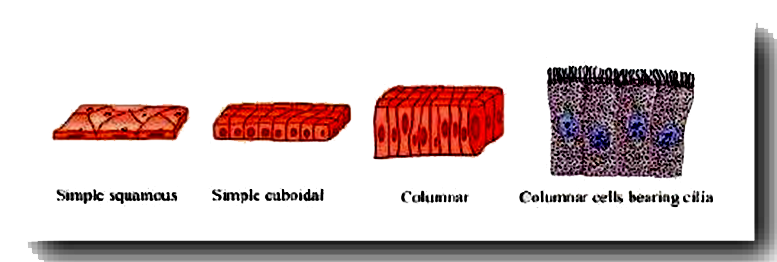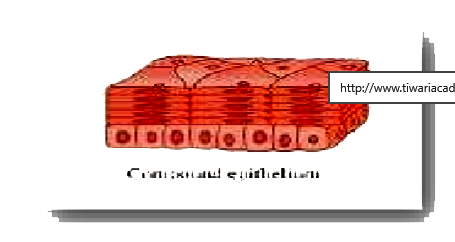Describe various types of epithelial tissues with the help of labelled diagrams.
Video Solution
Text Solution
Epithelial tissue lines the surface of a body and forms a protective covering. Epithelium cells are packed tightly together with little intercellular matrix. Epithelial tissue in the body is of two types.
(a) Simple epithelium: It consists of a single layer of cells where cells are in direct contact with the basement membrane. It is further sub-divided into the following types:
(i) Simple squamous epithelium: It consists of a single layer of flat cells with irregular boundaries. It is found in the walls of the blood vessels and in the lining of alveoli.
(ii) Simple cuboidal epithelium: It consists of a single layer of cube-like cells. It is present in regions where secretion and absorption of substances takes place such as the proximal convoluted tubule region of the nephron.
(iii) Simple columnar epithelium: It consists of a single layer of tall, slender cells with their nuclei present at the base of the cells. They may bear micro-villi on the free surfaces. Columnar epithelium forms the lining of the stomach and intestines, and is involved in the function of secretion and absorption.
(iv) Ciliated epithelium: It consists of columnar or cuboidal cells with cilia on their free surfaces. They are present in bronchioles and oviducts from where they direct mucus and eggs in specific directions.
(v) Glandular epithelium:It consists of columnar or cuboidal cells involved in the secretion of substances. Glands are of two types, unicellular glands (goblet cells of the alimentary canal) and multicellular glands (salivary glands). They can be classified as exocrine (ductless glands) and endocrine glands (duct glands) by the method through which they release enzymes.

(b) Compound epithelium: It consists of many layers of cells. It is involved mainly in the function of providing protection and has a limited role in secretion and absorption. Examples of compound epithelium include the dry surface of the skin or moist inner lining of the buccal cavity, pharynx, pancreatic ducts, and the inner lining of ducts of salivary glands.

|
Topper's Solved these Questions
Similar Questions
Epithelial tissue is
View SolutionIn epithelial tissue
View SolutionIn epithelial tissue
View SolutionExplain meiosis with the help of labelled diagrams.
View SolutionEpithelial tissues are
View SolutionDescribe the structure of the following with the help of labelled diagrams. (i) Nucleus (ii) Centrosome
View SolutionDescribe the structure of a human kidney with the help of a labelled diagram.
View SolutionDescribe the process of filtration with the help of a well-labelled diagram.
View SolutionDescribe the structure of a nucleosome with the help of a well-labelled diagram.
View SolutionDescribe various types of birth control measures.
View Solution